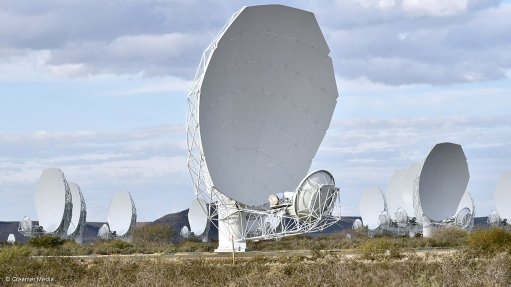
Photo by: Creamer Media's Donna Slater
South Africa’s MeerKAT radio telescope array is now involved in an international programme that is searching for extraterrestrial intelligence (SETI).
The announcement was made last month.
MeerKAT will be looking for what are called ‘technosignatures’, that is, indicators of technology, which would indicate the existence of extraterrestrial civilisations.
The programme is designated Breakthrough Listen, and already uses two renowned instruments – the Green Bank radio telescope (GBT) in the US, and the Parkes radio telescope in Australia, among others. Astronomers and engineers from Breakthrough Listen have, in conjunction with South African Radio Astronomy Observatory (Sarao) engineers, integrated their equipment with MeerKAT’s control and monitoring systems. The Breakthrough Listen instruments, developed over the past three years, are the most powerful digital systems ever created to hunt for technosignatures.
“MeerKAT consists of 64 dishes, which can see an area of the sky 50 times bigger than the GBT can view at once,” highlighted Breakthrough Listen principal investigator Dr Andrew Siemion. “Such a large field of view typically contains many stars that are interesting technosignatures targets. Our new supercomputer enables us to combine signals from the 64 dishes to get high resolution scans of these targets with excellent sensitivity, all without impacting the research of other astronomers who are using the array.”
While Breakthrough Listen sky scans with the GBT and Parkes instruments require that these be trained to point at specific targets, with MeerKAT these scans will normally not require the array’s dishes to be moved. MeerKAT also allows the SETI researchers to focus on 64 targets simultaneously, which has the further benefit of improving the identification and rejection of human technology-generated signals, for example from satellites orbiting the Earth.
“I am very excited to be able to conduct a search for technosignatures using one of the most sensitive telescopes in the world,” enthused Breakthrough Listen MeerKAT project scientist Dr Cherry Ng. “It will take us just two years to search over one-million nearby stars. MeerKAT will provide us with the ability to detect a transmitter akin to Earth’s brightest radio beacons out to a distance of 250 light years in our routine observing mode.”
Breakthrough Listen and Sarao are jointly developing research opportunities for African astronomers and data processing experts in the SETI programme. Breakthrough Listen is a leader in SETI, which has become an international research focus area.
“MeerKAT has a remarkable combination of sensitivity and survey speed, which makes it a wonderful telescope for SETI,” explained Sarao chief scientist Dr Fernando Camilo. “The telescope was planned and developed here in South Africa, and it’s very exciting that young South Africans will have the chance to be involved at the forefront of the search for life beyond Earth.”